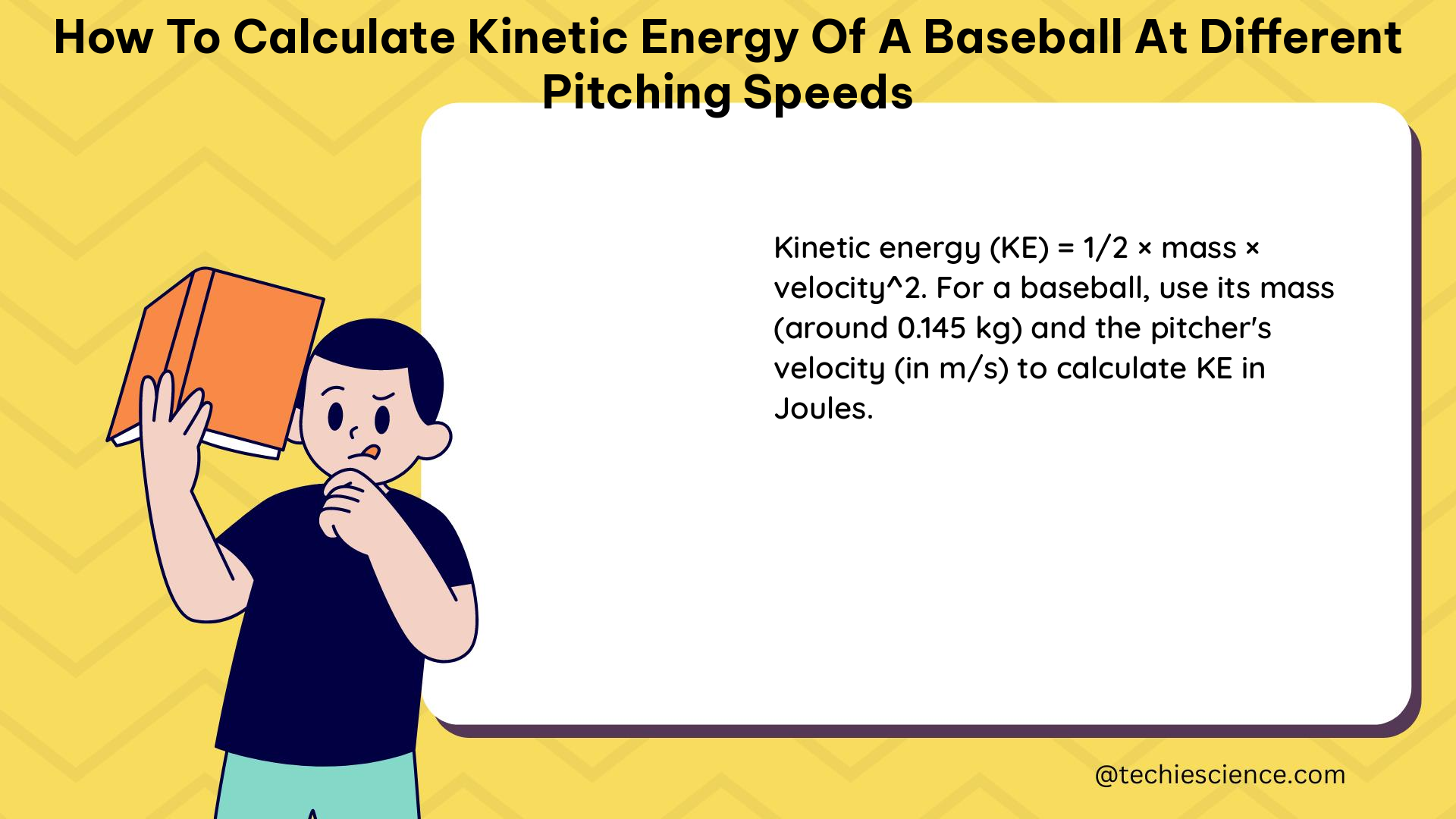The kinetic energy of a baseball at different pitching speeds can be calculated using the formula: E = 1/2 * m * v^2, where E is the kinetic energy (in joules), m is the mass of the baseball (in kilograms), and v is the velocity of the baseball (in meters per second).
Understanding the Kinetic Energy Formula
The kinetic energy formula is derived from the principles of classical mechanics. Kinetic energy is the energy of motion, and it is directly proportional to the mass of the object and the square of its velocity.
The formula can be broken down as follows:
1/2: This is a constant that represents the fact that kinetic energy is a scalar quantity, meaning it has magnitude but no direction.m: This is the mass of the baseball, which is typically around 0.145 kg (or 145 grams) for a regulation baseball.v^2: This is the square of the velocity of the baseball, which can vary greatly depending on the pitcher’s speed.
Calculating Kinetic Energy at Different Pitching Speeds

Let’s consider a few examples of how to calculate the kinetic energy of a baseball at different pitching speeds:
Example 1: 150 km/h (93 mph) Pitch
Given:
– Mass of the baseball, m = 0.145 kg
– Velocity of the baseball, v = 150 km/h = 41.67 m/s
Kinetic energy, E = 1/2 * m * v^2
E = 1/2 * 0.145 kg * (41.67 m/s)^2
E = 125.4 J
Example 2: 90 km/h (56 mph) Pitch
Given:
– Mass of the baseball, m = 0.145 kg
– Velocity of the baseball, v = 90 km/h = 25 m/s
Kinetic energy, E = 1/2 * m * v^2
E = 1/2 * 0.145 kg * (25 m/s)^2
E = 45.4 J
Example 3: 120 mph (193 km/h) Pitch
Given:
– Mass of the baseball, m = 0.170 kg (6 oz)
– Velocity of the baseball, v = 120 mph = 53.64 m/s
Kinetic energy, E = 1/2 * m * v^2
E = 1/2 * 0.170 kg * (53.64 m/s)^2
E = 244.5 J
Relationship between Kinetic Energy and Velocity
As you can see from the examples, the kinetic energy of a baseball increases exponentially with its velocity. This is because the kinetic energy is proportional to the square of the velocity.
For instance, if the velocity of the baseball is doubled, the kinetic energy will increase by a factor of 4 (2^2 = 4). Conversely, if the velocity is halved, the kinetic energy will decrease by a factor of 4.
This relationship between kinetic energy and velocity is one of the reasons why pitchers who can throw at high velocities are highly valued in baseball. The increased kinetic energy of the baseball can make it more difficult for batters to hit effectively.
Factors Affecting Kinetic Energy
In addition to the velocity of the baseball, there are other factors that can affect its kinetic energy:
-
Mass: The mass of the baseball can vary slightly, typically between 142-149 grams (0.142-0.149 kg) for a regulation baseball. A heavier baseball will have more kinetic energy at the same velocity.
-
Atmospheric Conditions: The air density and temperature can affect the velocity of the baseball, which in turn affects its kinetic energy. For example, a baseball thrown in a high-altitude, low-density environment may have a higher velocity and kinetic energy compared to the same pitch at sea level.
-
Spin Rate: The spin rate of the baseball can also influence its trajectory and velocity, which can affect the kinetic energy. Pitchers who can impart a high spin rate on the ball may be able to achieve higher velocities and, consequently, higher kinetic energy.
Conclusion
In summary, to calculate the kinetic energy of a baseball at different pitching speeds, you can use the formula E = 1/2 * m * v^2, where E is the kinetic energy (in joules), m is the mass of the baseball (in kilograms), and v is the velocity of the baseball (in meters per second). The kinetic energy of a baseball increases exponentially with its velocity, which is one of the reasons why high-velocity pitchers are so valuable in baseball.
References
- The Energy Behind a High Velocity Fastball – Engineered Athletics (https://engineeredathletics.com/2017/06/19/the-energy-behind-a-high-velocity-fastball/)
- How much energy does a pitcher transfer to a 0.20 kg baseball while throwing it to a speed of 45 m/s? (https://homework.study.com/explanation/how-much-energy-does-a-pitcher-transfer-to-a-0-20-kg-baseball-while-throwing-it-to-a-speed-of-45-m-s.html)
- What is the kinetic energy, in joules, of this baseball when it is thrown by a major league pitcher at 150 km/h? (https://www.vaia.com/en-us/textbooks/chemistry/chemistry-the-central-science-in-si-units-global-edition-14-edition/chapter-1/problem-26-a-a-baseball-weighs-1454-mathrmg-what-is-the-kine/)
- Speed and Kinetic Energy of Sports Pitches, Shots and Kicks (https://engaging-data.com/kinetic-energy-sports/)
- Calculate the kinetic energy of a baseball (mass 6 oz) with a velocity of 120 miles/hour (https://www.youtube.com/watch?v=KnumHRtdGl4)

The lambdageeks.com Core SME Team is a group of experienced subject matter experts from diverse scientific and technical fields including Physics, Chemistry, Technology,Electronics & Electrical Engineering, Automotive, Mechanical Engineering. Our team collaborates to create high-quality, well-researched articles on a wide range of science and technology topics for the lambdageeks.com website.
All Our Senior SME are having more than 7 Years of experience in the respective fields . They are either Working Industry Professionals or assocaited With different Universities. Refer Our Authors Page to get to know About our Core SMEs.